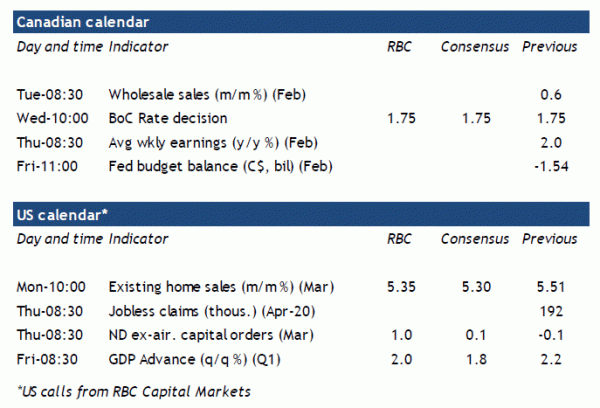Next week is all about the Bank of Canada. While no one expects a change in interest rates, hopes are Wednesday’s policy statement and Monetary Policy Report will provide clues into just how long the central bank might remain on the sidelines. A run of soft economic data—including this week’s Business Outlook Survey—have given Governor Poloz and Co. plenty of cover to take a more dovish stance. The BoC barely clung to a tightening bias in its March statement, noting that accommodative policy was still warranted and that the timing of future rate hikes was increasingly uncertain. Recent comments from Governing Council have emphasized the first part of that guidance—that conditions call for the BoC’s policy rate to stay below its longer-run neutral range, currently pegged at 2.5-3.5%. We expect the BoC will make its shift to a neutral policy bias official by dropping any reference to future rate hikes. And to end the policy statement by again emphasizing its dependence on data, with a particular focus on oil markets, household spending, and global trade policy. Given recent disappointing home sales, we wouldn’t be surprised if developments in the Canadian housing market were added to that list. The shift to a neutral bias shouldn’t come as a surprise to investors who are already pricing in some chance of a rate cut by the end of the year.
April’s MPR will include fresh economic projections. The BoC was slightly ahead of other forecasters in predicting slower global growth this year, so its global GDP forecast likely won’t change significantly. Its US projection looks about right even with more moderate growth to start the year (Q1 GDP to be released next Friday); only its euro-area forecast stands out as overly optimistic. Domestically, a greater-than-expected slowdown over the winter should see the central bank cut its 2019 Canadian GDP forecast from 1.7%, likely closer to our 1.5% call. We think its forecast will continue to show a return to above-trend growth later this year as the drag from the energy and housing sectors eases. An eventual closing of the output gap may well be consistent with more neutral monetary policy over time. However, the combination of slower credit growth, limited inflationary pressure, and a dovish shift from other central banks leaves little urgency to raise interest rates further. Our forecast assumes the BoC will be on hold through 2020.


 Signal2forex.com - Best Forex robots and signals
Signal2forex.com - Best Forex robots and signals




